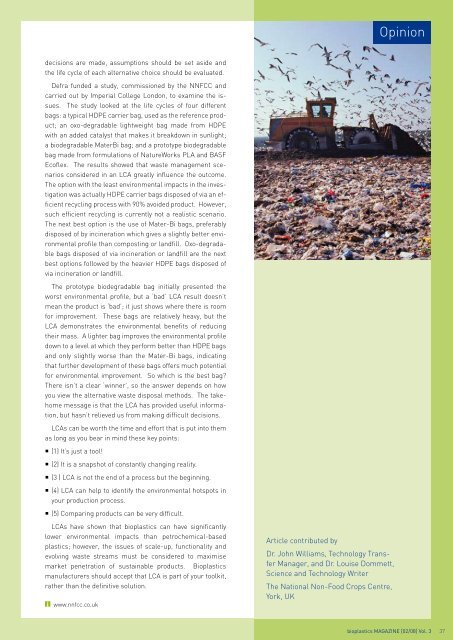02 | 2008
You also want an ePaper? Increase the reach of your titles
YUMPU automatically turns print PDFs into web optimized ePapers that Google loves.
Opinion<br />
decisions are made, assumptions should be set aside and<br />
the life cycle of each alternative choice should be evaluated.<br />
Defra funded a study, commissioned by the NNFCC and<br />
carried out by Imperial College London, to examine the issues.<br />
The study looked at the life cycles of four different<br />
bags: a typical HDPE carrier bag, used as the reference product;<br />
an oxo-degradable lightweight bag made from HDPE<br />
with an added catalyst that makes it breakdown in sunlight;<br />
a biodegradable MaterBi bag; and a prototype biodegradable<br />
bag made from formulations of NatureWorks PLA and BASF<br />
Ecoflex. The results showed that waste management scenarios<br />
considered in an LCA greatly influence the outcome.<br />
The option with the least environmental impacts in the investigation<br />
was actually HDPE carrier bags disposed of via an efficient<br />
recycling process with 90% avoided product. However,<br />
such efficient recycling is currently not a realistic scenario.<br />
The next best option is the use of Mater-Bi bags, preferably<br />
disposed of by incineration which gives a slightly better environmental<br />
profile than composting or landfill. Oxo-degradable<br />
bags disposed of via incineration or landfill are the next<br />
best options followed by the heavier HDPE bags disposed of<br />
via incineration or landfill.<br />
The prototype biodegradable bag initially presented the<br />
worst environmental profile, but a ‘bad’ LCA result doesn’t<br />
mean the product is ‘bad’; it just shows where there is room<br />
for improvement. These bags are relatively heavy, but the<br />
LCA demonstrates the environmental benefits of reducing<br />
their mass. A lighter bag improves the environmental profile<br />
down to a level at which they perform better than HDPE bags<br />
and only slightly worse than the Mater-Bi bags, indicating<br />
that further development of these bags offers much potential<br />
for environmental improvement. So which is the best bag?<br />
There isn’t a clear ‘winner’, so the answer depends on how<br />
you view the alternative waste disposal methods. The takehome<br />
message is that the LCA has provided useful information,<br />
but hasn’t relieved us from making difficult decisions.<br />
LCAs can be worth the time and effort that is put into them<br />
as long as you bear in mind these key points:<br />
• (1) It’s just a tool!<br />
• (2) It is a snapshot of constantly changing reality.<br />
• (3 ) LCA is not the end of a process but the beginning.<br />
• (4) LCA can help to identify the environmental hotspots in<br />
your production process.<br />
• (5) Comparing products can be very difficult.<br />
LCAs have shown that bioplastics can have significantly<br />
lower environmental impacts than petrochemical-based<br />
plastics; however, the issues of scale-up, functionality and<br />
evolving waste streams must be considered to maximise<br />
market penetration of sustainable products. Bioplastics<br />
manufacturers should accept that LCA is part of your toolkit,<br />
rather than the definitive solution.<br />
www.nnfcc.co.uk<br />
Article contributed by<br />
Dr. John Williams, Technology Transfer<br />
Manager, and Dr. Louise Dommett,<br />
Science and Technology Writer<br />
The National Non-Food Crops Centre,<br />
York, UK<br />
bioplastics MAGAZINE [<strong>02</strong>/08] Vol. 3 37


















